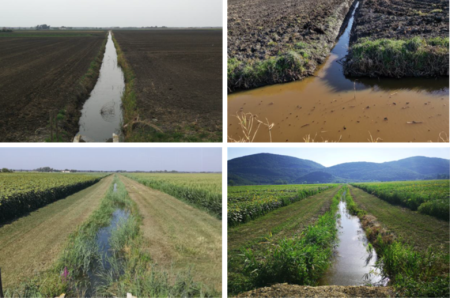
Area characterisation:
The Serchio River Basin is defined as a basin of national interest according to Italian law. It has been identified as a ‘river basin district’ for implementing the EU’s Water Framework Directive. The unique combination of challenges that are present includes extreme drought and flooding, seismic risk as well as water pollution.
The “Autorita di Bacino Distrettuale dell’Appennino Settentrionale” is the authority that leads efforts to address these risks in a portion of the river basin, Massaciuccoli Lake, through the design and implementation of diversion channel which has been funded by the Ministry of the Environment and the Protection of the Territory and the Sea. The water supply through the diversion channel has been coupled with implementing several NbS techniques to mitigate the effects of climate change and simultaneously increase biodiversity and improve water quality
Objective:
The main problem to solve with the implemented NbS measures is the runoff of soil and pollutants from the farmland to irrigation canals and from there to the nearby Lake Massaciuccoli on the Tuscan coast.
Through the H2020 project PHUSICOS two canals (canals Fossetto and Fossaccio) have been modified to improve the hydraulic capacity
Potential impacts/benefits:
- increase flood-mitigation capacity
- reduce runoff of pollutants from the farmland
- a cleaner lake
- well-being for inhabitants and for tourists, as this is an important tourist area
- carbon storage with increased vegetation, which is not harvested
- boosting local green economy
- creating increased cooperation, enthusiasm, and sense of ‘ownership’ among stakeholders (farmers)
Actions:
The modification consists of changing the cross section of the canals. The original trapezoidal cross section is enlarged by constructing small floodplains along the banks, increasing the effective section of the canals during flooding events. Furthermore, the modified cross section provides a better environment for the bank vegetation, which in addition to mitigating against erosion, also will have an ability to absorb pollutants. The bank vegetation consists of Phragmites australis and Thypha latifolia.
Different sections of the canals have been modified in three different ways, depending on the width of the original canal and the conditions of the banks:
- Wide original canal: Unaltered canal profile but with 6 m wide buffer strip and vegetation on the bottom and banks.
- Intermediate width of original canal: Excavating one bank to widen the canal, 6 m wide buffer strips and vegetation on the bottom and banks.
- Narrow original canal width: Excavating both banks to widen the canal, 6 m wide buffer strips and vegetation on the bottom and banks.
The "Autorita di Bacino Distrettuale dell’Appennino Settentrionale" has collaborated with stakeholders (local farmers and other organizations) to implement these NBSs, including the maintenance and monitoring plans, and explore planning strategies with the overall goal of developing an ecosystem-based management approach for hydrogeological risk reduction in the whole area of the Massaciuccoli Lake.
Transferability of result:
The potential for upscaling is high in this area, and it is hoped that this will foster the implementation of a territorial management strategy for overcoming the challenging issues associated with runoff from the farmland and mitigating floods.
Lessons learnt:
Living Lab helped with increased cooperation, enthusiasm, and sense of ‘ownership’ among stakeholders (farmers).
Organisations:
The chanal modifications have been implemented through the H2020 project PHUSICOS .
The “Autorita di Bacino Distrettuale dell’Appennino Settentrionale” (ADBS) is the authority that leads efforts to address these risks.
The involved farmers were the ones who carried out the physical work, using their own machinery and personnel
NBS benefits:
- Developing climate change adaptation; improving risk management and resilience
- Reduce flood risk
- Improve water quality
- Increase awareness of NBS solution & their effectiveness and co benefits
- Increase communities’ sense of ownership